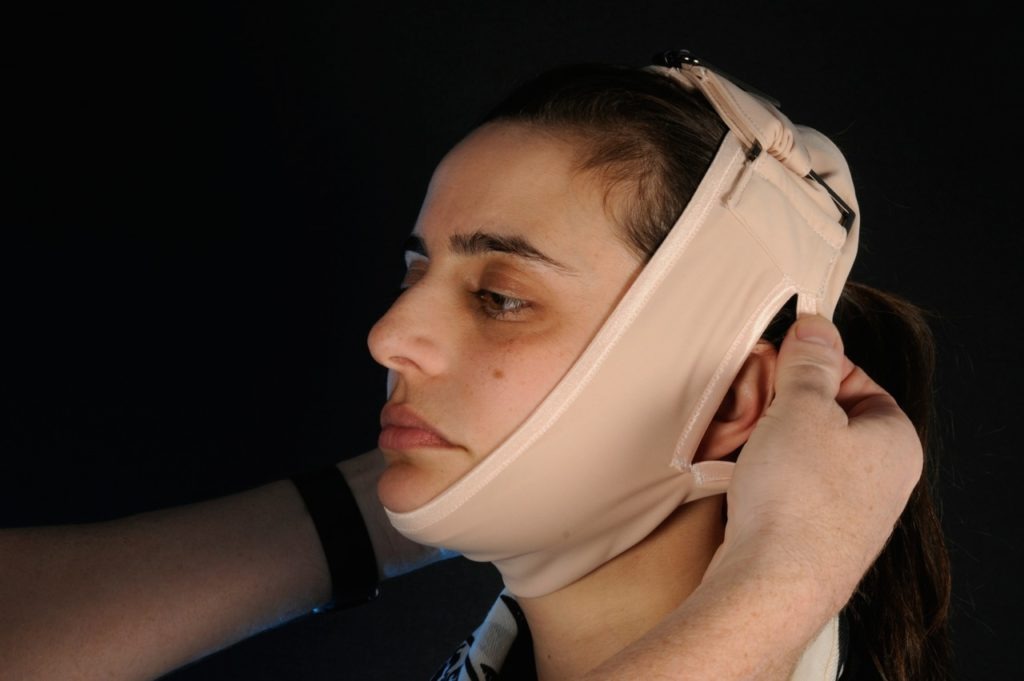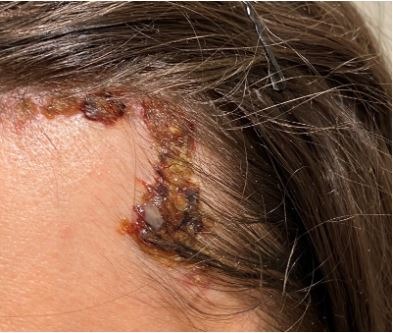Postoperative instructions
Table of contents:
Sutures and staples
- Absorbable — Only the blue or black sutures need to be removed (after Adam’s Apple reduction, blepharoplasty or lip lift). All white skin sutures are absorbable within about 2 weeks, so don’t need to be removed. In case staples have been used they need to be removed 8 days after the surgery.
Moving
- Move as soon as possible — It is important to try to move your limbs as soon as possible after surgery, to prevent blood clots. Do not stay in bed for extended periods of time during the day.
Medication
- Pain medication— We'll provide you with medication during your pre-operative consult. In case you need more medication at one point, ask us.
- Dafalgan-Codeine — Every 4 hours, max 6 a day.
- Diclofenac — Every 6 hours, max 4 a day.
- Mouth rinse — We will provide you with a post-surgical antiseptic mouthwash to take care of the intra-oral incisions. Read up on the specific instructions below according to the procedure(s) you've had.
Swelling and bruising
- Tightness — Feelings of tightness and warmth, due to swelling, are normal and will subside over time.
- Icepacks — Icepacks can be found in the fridge in the hallway of the guesthouse. In the guesthouse we also have a cooling system in place especially for the eyes. Use the machine as well as the ice packs as much as possible. It really helps.
- Leakage — In case you had a big hematoma (cheek, neck after Adam’s Apple reduction) it might become fluid again after a few days. This could cause some old blood leaking from the wound. This is not fresh bleeding but a way for your body to get rid of the hematoma.
- Evolution — Swelling is on its maximum 2 to 3 days after surgery. Swelling and bruising may be present for up to 2-4 weeks. It may take up to 3-6 months to see the final results. Patience is required.
- Place and extensiveness — Immediately after surgery the swelling will be mostly in areas of loose connective tissue (cheeks, lips, around eyes). During the first few days, the swelling will move downwards towards the lower jaw and neck due to gravity. Swelling and bruising differ strongly from one person to another and can be anywhere. Bruising may not appear immediately and will gradually fade over the course of several weeks.
- Elevation — Try to sleep elevated (ask for extra pillows). This helps the drainage and will alleviate the swelling.
Incisions
- Cleaning — The incision areas should be cleaned carefully on a daily basis in the shower. Remove the crusts and pat the area dry carefully. If you don't remove the crusts, there is the risk of getting an ugly scar. Removing the crusts is very important. After about 2 weeks the wounds will be healed enough to potentially begin applying a special ointment to improve the scars (cicaplast).
- Make-up — You may wear light make-up 7-10 days after surgery to help camouflage the incisions and bruising.
- Sunbathing — The young scar is very sensitive to the sun´s rays as it contains very few melanocytes. Therefore during the first 6 months after surgery, we recommend protecting the scar with sunblock or to stay out of the sun. During the first week after surgery, it’s better to stay out of the sun completely as the risk for infection might be higher if your face and body get too warm.
- Washing the hair — If you had forehead surgery the first 2 weeks after surgery you should wash your hair every day. For good wound healing, it’s important to remove all blood clots and crusts, even better when you use shampoo. Don’t be alarmed if the wound bleeds a little bit while washing your hair. If you also have an aluminum cast on your nose (rhinoplasty), the cast should stay dry.
- Scar ointment — After the wounds have closed (after two weeks), you may begin gentle massage of the incision sites with the scar ointment gel (Cicaplast). The scar ointment gel is very simple to apply and should be used at least twice a day. The recommended minimum duration of treatment is two months.
After forehead recontouring
- Double vision — It is possible the first two weeks because of the swelling around the eyes double vision occurs (5 percent of patients). This is annoying and even worrying but ALWAYS resolves. We never had a patient with permanent double vision.
After mid-facelift, canthopexy, and blepharoplasty
- Upward massage of the lid — To prevent ectropion (lid margin eversion) two weeks after surgery you should start regular upward massage of the lid several times daily for 3 to 5 minutes. This will improve the lid tone and lid position. Often when performing the transcutaneous blepharoplasty the orbicularis muscle is denervated and the lid tone is diminished. As the tone of the muscle returns the lid position should as well. Lower blepharoplasty takes one year to fully mature into postoperative results.
After facelift and jaw reduction and chin recontouring
- Facemask — The facemask provided is meant to give support to the soft tissues of your face after surgery. It keeps them in their desired position, prevents dead spaces and the creation of scar tissue in them and reduces postoperative swelling. The facemask should be worn 24 hours a day during the 3 days. That is really important for the proper re-attachment of the chin muscle to the bone. Only during eating and showering it can be removed for a short while. Dr van Nimmen will tell you during the preoperative consultation whether the facemask should be worn afterward or not. It can be washed at 60°C.

- Soft food— If you had a sliding genioplasty (= detaching the chin bone from the lower jaw, sliding it back or forward and screwing it in place), you should not put force on your lower jaw during the first 4 weeks after surgery as it could break in the chin area. During these 4 weeks you shouldn’t eat raw meat or bite apples etc. Eat pasta or rice, well-cooked vegetables, and soft meat. Those shouldn’t pose any problems.
- If you didn’t have a a sliding genioplasty, you might still choose to eat soft food during the first few days because of the wounds and swelling on the inside of your mouth, but you can basically eat whatever you like.
- If you notice you can not open your mouth enough after jaw surgery—Muscles may have a cramped reaction after surgery. If this happens it is important to exercise the opening of the mouth every hour for 5 minutes with wooden sticks. Click here to watch a video with instructions of how to do this.
- Mouth rinse — We will provide you with a post-surgical antiseptic mouthwash to take care of the intra-oral incisions. You should rinse after every meal. However, you should clean your teeth with a toothbrush, toothpaste and dental floss as soon as possible after your jaw reduction.
- Important! Do not brush your lower front teeth the first week after your chin surgery. You could damage the sutures, which are close to your teeth. After 1 week you should clean the lower front teeth twice a day with an extra soft tooth brush.
- The intra-oral incisions are absorbable and should not be removed. They will dissolve after about two weeks. When the bottle of mouth rinse is finished you can stop the usage.
After nose surgery
- Aluminum cast — An aluminum cast will be placed on your nose and adhered with tape. It should stay on the nose for a week.
- Vaseline — No crust may be formed in the nose as this is not good for healing. The crust has to be removed. Vaseline 3 times a day helps to soften the crusts so you can remove them gently.
- Breathing — Most people find it very difficult not being able to breathe through their noses after their rhinoplasty. We will give you some nose drops to open up the nose during your preoperative consultation.
- Stitches — The stitches underneath the nose will be removed by Dr Bart van Nimmen 7 days after the surgery.
- Bleeding — Some sporadic bleeding could be expected during the first couple of weeks, which is normal and should not be cause for concern.
- Bruising — Most people get bruising around the eyes and cheeks. The bruises under the eyes will intensify during two or three days before they begin to vanish. 15 days later, only you and your surgeon will be able to notice any traces of the surgery.
- Appearance — Your nose will regain its normal appearance very soon, but the definitive results of the rhinoplasty can only be fully appreciated after six months. The tip is the area that takes the longest to acquire its new shape.
After hairline lowering surgery
- Sutures — After 2–3 weeks the absorbable sutures at the hairline will fall out.
- To prevent infection, we recommend taking azithromycin once a day after meals for the first 3 days after surgery.
- In case of infection (e.g. S. Aureus) — As with any surgery, infection can occur (see photo below). With hairline lowering surgery, it can be extra tricky to keep the surgical area clean and sterile during aftercare. Tiny hairs can grow inward into or below the skin which can cause irritation or infection. Usually these tiny hairs can be removed using sterile tweezers. In case of an infection, we advise you to:

- use Floxapen 500mg (flucloxacillin) 4 times a day during 14 days;
- use Fucidin ointment for 14 days;
- clean the wound twice a day with chlorhexidine in water;
- use Flaminal or Flammazine ointment on the wound twice a day;
- to send an evaluation of the treatment after 10 days by sending pictures to Dr. van Nimmen.
- Scar — The scar will remain red and elevated for a period of 2-6 months. After about 6 weeks small hairs will start to grow through the scar, making it less visible.
- Numbness — All patients experience numbness of the front of the scalp. Sensation will return within 3 to 12 months. Sometimes there is an itching sensation during the recovery period.
- Temporary loss of hair — There can be some shedding of the fine hairs in the front of the scalp within 2-4 weeks after surgery. This is called an “effluvium”. The hair normally grows back after 3 months. We sometimes suggest the use of 5% Minoxidil to the front of the hair-bearing scalp after surgery. This can lessen the possible hair loss and promote more rapid growth of hair that might have been shed and of hair that will be growing through the incision.
- Result — Full recovery is to be expected after 12-18 months when the scar will have reached its full maturity. There will be a visible scar, but it is usually too faint to even notice after one year.
We are doing our very best to keep this information up-to-date. In case you see anything that no longer seems accurate, or in case you have a question, please fill out the form below.
